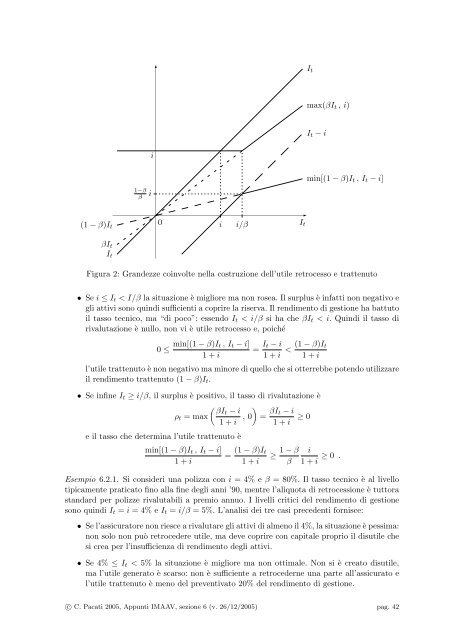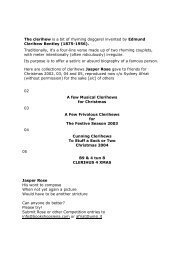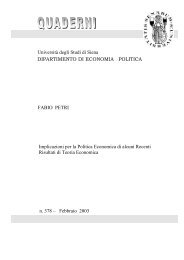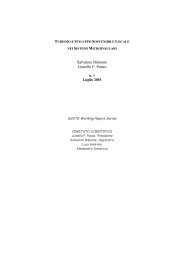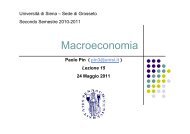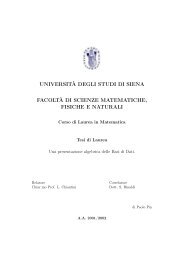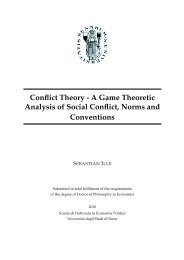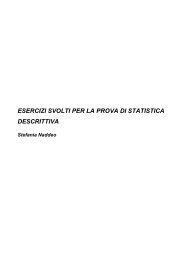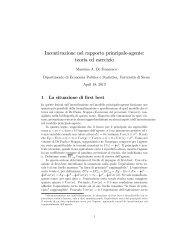Appunti delle lezioni di istituzioni di matematica attuariale per le ...
Appunti delle lezioni di istituzioni di matematica attuariale per le ...
Appunti delle lezioni di istituzioni di matematica attuariale per le ...
You also want an ePaper? Increase the reach of your titles
YUMPU automatically turns print PDFs into web optimized ePapers that Google loves.
(1 − β)It<br />
βIt<br />
It<br />
i<br />
1−β<br />
β i<br />
0 i i/β<br />
It<br />
It<br />
max(βIt , i)<br />
It − i<br />
min[(1 − β)It , It − i]<br />
Figura 2: Grandezze coinvolte nella costruzione dell’uti<strong>le</strong> retrocesso e trattenuto<br />
• Se i ≤ It < I/β la situazione è migliore ma non rosea. Il surplus è infatti non negativo e<br />
gli attivi sono quin<strong>di</strong> sufficienti a coprire la riserva. Il ren<strong>di</strong>mento <strong>di</strong> gestione ha battuto<br />
il tasso tecnico, ma “<strong>di</strong> poco”: essendo It < i/β si ha che βIt < i. Quin<strong>di</strong> il tasso <strong>di</strong><br />
rivalutazione è nullo, non vi è uti<strong>le</strong> retrocesso e, poiché<br />
0 ≤ min[(1 − β)It , It − i]<br />
1 + i<br />
= It − i<br />
1 + i<br />
< (1 − β)It<br />
1 + i<br />
l’uti<strong>le</strong> trattenuto è non negativo ma minore <strong>di</strong> quello che si otterrebbe potendo utilizzare<br />
il ren<strong>di</strong>mento trattenuto (1 − β)It.<br />
• Se infine It ≥ i/β, il surplus è positivo, il tasso <strong>di</strong> rivalutazione è<br />
<br />
βIt − i<br />
ρt = max , 0 =<br />
1 + i<br />
βIt − i<br />
≥ 0<br />
1 + i<br />
e il tasso che determina l’uti<strong>le</strong> trattenuto è<br />
min[(1 − β)It , It − i]<br />
1 + i<br />
= (1 − β)It<br />
1 + i<br />
≥ 1 − β<br />
β<br />
i<br />
≥ 0 .<br />
1 + i<br />
Esempio 6.2.1. Si consideri una polizza con i = 4% e β = 80%. Il tasso tecnico è al livello<br />
tipicamente praticato fino alla fine degli anni ’90, mentre l’aliquota <strong>di</strong> retrocessione è tuttora<br />
standard <strong>per</strong> polizze rivalutabili a premio annuo. I livelli critici del ren<strong>di</strong>mento <strong>di</strong> gestione<br />
sono quin<strong>di</strong> It = i = 4% e It = i/β = 5%. L’analisi dei tre casi precedenti fornisce:<br />
• Se l’assicuratore non riesce a rivalutare gli attivi <strong>di</strong> almeno il 4%, la situazione è pessima:<br />
non solo non può retrocedere uti<strong>le</strong>, ma deve coprire con capita<strong>le</strong> proprio il <strong>di</strong>suti<strong>le</strong> che<br />
si crea <strong>per</strong> l’insufficienza <strong>di</strong> ren<strong>di</strong>mento degli attivi.<br />
• Se 4% ≤ It < 5% la situazione è migliore ma non ottima<strong>le</strong>. Non si è creato <strong>di</strong>suti<strong>le</strong>,<br />
ma l’uti<strong>le</strong> generato è scarso: non è sufficiente a retrocederne una parte all’assicurato e<br />
l’uti<strong>le</strong> trattenuto è meno del preventivato 20% del ren<strong>di</strong>mento <strong>di</strong> gestione.<br />
c○ C. Pacati 2005, <strong>Appunti</strong> IMAAV, sezione 6 (v. 26/12/2005) pag. 42


